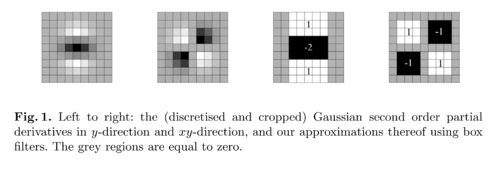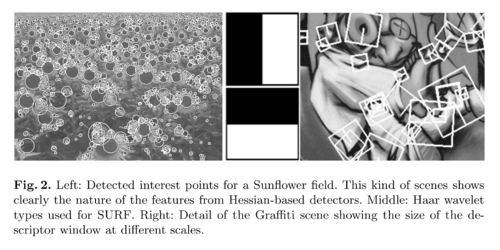SURF: Speeded Up Robust Features: Difference between revisions
Appearance
| (7 intermediate revisions by the same user not shown) | |||
| Line 1: | Line 1: | ||
* [https://link.springer.com/chapter/10.1007/11744023_32 Springer Link to Paper (ECCV 2006) Paywall] | |||
* [http://people.ee.ethz.ch/~surf/eccv06.pdf Paper] | |||
* [[Media:Surf_speeded_up_robust_features_eccv06.pdf | Mirror]] | |||
* | ;Authors: | ||
* Herbert Bay - ETH Zurich | |||
* Tinne Tuytelaars - Katholieke Universiteit Leuven | |||
* Luc Van Gool - ETH Zurich, Katholieke Universiteit Leuven | |||
==Feature Extraction== | ==Feature Extraction== | ||
| Line 7: | Line 13: | ||
Our features will be regions in the image where the determinant of the Hessian are local maxima. | Our features will be regions in the image where the determinant of the Hessian are local maxima. | ||
[[File:surf_fig_1.png | thumb | 500px | Figure 1 from the paper. Each region can be computed using a summed area table/integral image.]] | |||
* The Hessian matrix: | * The Hessian matrix: | ||
<math>\mathcal{H}(\mathbf{x}, \sigma) | <math>\mathcal{H}(\mathbf{x}, \sigma) | ||
| Line 14: | Line 22: | ||
\end{bmatrix}</math> | \end{bmatrix}</math> | ||
* Each entry is a convolution of a the Gaussian second order derivative with the image at <math>\mathbf{x}</math> | * Each entry is a convolution of a the Gaussian second order derivative with the image at <math>\mathbf{x}</math> | ||
* These convolutions are approximated using box filters on an integral image. | * These convolutions are approximated using box filters on an integral image (Fig 1). | ||
*: The approximations are denoted as <math>D_{xx}, D_{yy}, D_{xy}</math> | *: The approximations are denoted as <math>D_{xx}, D_{yy}, D_{xy}</math> | ||
* The determinant of the hessian is then <math>D_{xx}D_{yy} - (0.9*D_{xy})^2</math> | * The determinant of the hessian is then <math>D_{xx}D_{yy} - (0.9*D_{xy})^2</math> | ||
| Line 33: | Line 41: | ||
===Orientation Assignment=== | ===Orientation Assignment=== | ||
[[File:Surf fig 2.png | thumb | 500px | Figure 2 from the paper]] | |||
* Sample Haar-wavelet responses in x and y-direction at points around each feature | * Sample Haar-wavelet responses in x and y-direction at points around each feature | ||
** Using integral images, only 6 operations are need to compute in x or y direction | ** Using integral images, only 6 operations are need to compute in x or y direction (Fig. 2 middle) | ||
**: We have 6 distinct corners so we need | **: We have 6 distinct corners so we need 6 fma operations in total for each direction. (Actually 5 if one value is just multiplied by 1) | ||
* Using a 360-degree (pivoting) sliding window with radius <math>\frac{\pi}{3}</math>, calculate the sum of all horizontal and vertical responses yielding vector. Note the window moves in increments of <math>\frac{\pi}{3}</math> | * Using a 360-degree (pivoting) sliding window with radius <math>\frac{\pi}{3}</math>, calculate the sum of all horizontal and vertical responses yielding vector. Note the window moves in increments of <math>\frac{\pi}{3}</math> | ||
* Pick the direction with the largest vector. | * Pick the direction with the largest vector. | ||
===Descriptor Components=== | ===Descriptor Components=== | ||
* Create square regions positioned at feature points and oriented using the calculated orientation | * Create square regions positioned at feature points and oriented using the calculated orientation (Fig. 2 right) | ||
* ... | * ... | ||
==OpenCV== | |||
SURF is available in OpenCV | |||
==Resources== | ==Resources== | ||
* [https://medium.com/data-breach/introduction-to-surf-speeded-up-robust-features-c7396d6e7c4e Medium Introduction] | * [https://medium.com/data-breach/introduction-to-surf-speeded-up-robust-features-c7396d6e7c4e Medium Introduction] | ||
Latest revision as of 12:57, 23 April 2020
- Authors
- Herbert Bay - ETH Zurich
- Tinne Tuytelaars - Katholieke Universiteit Leuven
- Luc Van Gool - ETH Zurich, Katholieke Universiteit Leuven
Feature Extraction
Fast-Hessian Detector
Our features will be regions in the image where the determinant of the Hessian are local maxima.

- The Hessian matrix:
\(\displaystyle \mathcal{H}(\mathbf{x}, \sigma) = \begin{bmatrix} L_{xx}(\mathbf{x}, \sigma) & L_{xy}(\mathbf{x}, \sigma)\\ L_{xy}(\mathbf{x}, \sigma) & L_{yy}(\mathbf{x}, \sigma) \end{bmatrix}\)
- Each entry is a convolution of a the Gaussian second order derivative with the image at \(\displaystyle \mathbf{x}\)
- These convolutions are approximated using box filters on an integral image (Fig 1).
- The approximations are denoted as \(\displaystyle D_{xx}, D_{yy}, D_{xy}\)
- The determinant of the hessian is then \(\displaystyle D_{xx}D_{yy} - (0.9*D_{xy})^2\)
- 0.9 is a correction term for the approximation
- \(\displaystyle \frac{|L_{xy}(1.2)|_{F}}{|L_{xx}(1.2)|_{F}}\frac{|D_{xx}(9)|_{F}}{|D_{xy}(9)|_{F}} = 0.912\)
- 0.9 is a correction term for the approximation
- Interest points are local extrema of the determinant and trace of the Hessian
Scale-space representation
- They can increase (e.g. double) the filter size for their approximation and to get representations at multiple scales.
- They apply a "non-maximum suppression in a \(\displaystyle 3 \times 3 \times 3\) neighborhood" to "localise interest points in the image and over scales"
- Non-maximum suppression is a filtering technique to remove duplicates
- Basic idea: Let B be a set of regions. Let D be the filtered set we want to output.
- Pick the max confidence region from set B to D. Remove it from B.
- For each region in B, delete it if the IOU with selected is > threshold.
- See non-maximum suppression
- Non-maximum suppression is a filtering technique to remove duplicates
SURF Descriptor
Orientation Assignment

- Sample Haar-wavelet responses in x and y-direction at points around each feature
- Using integral images, only 6 operations are need to compute in x or y direction (Fig. 2 middle)
- We have 6 distinct corners so we need 6 fma operations in total for each direction. (Actually 5 if one value is just multiplied by 1)
- Using integral images, only 6 operations are need to compute in x or y direction (Fig. 2 middle)
- Using a 360-degree (pivoting) sliding window with radius \(\displaystyle \frac{\pi}{3}\), calculate the sum of all horizontal and vertical responses yielding vector. Note the window moves in increments of \(\displaystyle \frac{\pi}{3}\)
- Pick the direction with the largest vector.
Descriptor Components
- Create square regions positioned at feature points and oriented using the calculated orientation (Fig. 2 right)
- ...
OpenCV
SURF is available in OpenCV
